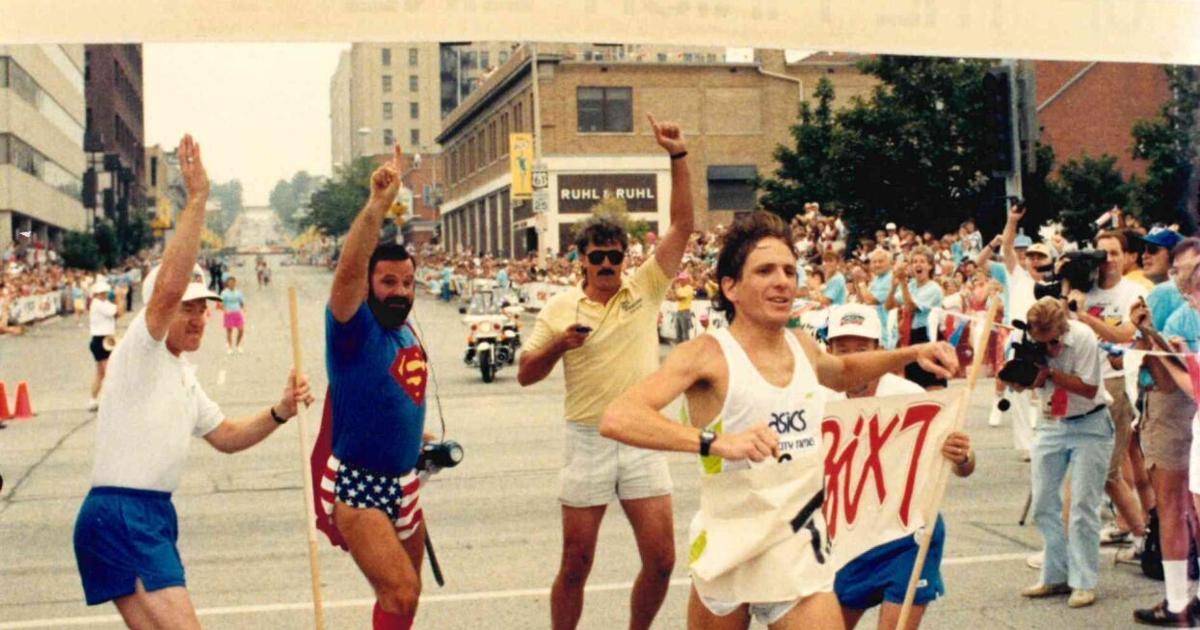For Nenow, there was no business like shoe business

Mark Nenow spent most of the 1980s wearing out running shoes, frequently logging 140 miles a week.
He then spent more than 30 years designing and marketing shoes for some of the largest companies in the country.
Near the end of his running career, Nenow etched his name in Quad-City Times Bix 7 history by winning the race in the first year that it offered prize money.
He breezed to victory in the 1989 Bix 7, winning easily in what was then a course record time of 32 minutes, 17 seconds. His time still stands as the American record for the Bix.
It was a landmark year for the Bix in several ways. The race exceeded 15,000 runners for the first time. It offered prize money to the top 10 male and female finishers, also for the first time. And it had a new downhill finish that ended on the riverfront, in the parking lot of the new President Riverboat Casino.
Nenow already was a prominent name on the U.S. running scene by then. The North Dakota native had been a star at the University of Kentucky and set the U.S. record in the 10,000 meters in 1986. His mark stood for nearly 15 years before it was topped by another Bix icon, Meb Keflezighi.
But Nenow narrowly missed making the U.S. Olympic team in 1988, finishing fourth in the 10,000 meters and fifth in the 5,000 at the trials, and his victory at the Bix was one of last high-profile moments in his career.
By 1991, he had retired from running and was employed in the footwear industry for ASICS. He subsequently spent 11 years working for Nike and a couple of years with Brooks before becoming vice president of global footwear merchandising for Columbia.
In 2015, he was named president of Sorel, a division of Columbia, and led that brand to $347 million in net sales in 2022. He resigned from that post for health reasons in June of last year.
Catching up with other former Bix 7 men’s champions:
- Lucian Rosa (1975) was denied the chance to represent his native Sri Lanka in the 1976 Olympics because of a boycott to protest apartheid in South Africa. He coached cross country at Wisconsin-Parkside from 1997 through 2007, and he and 1975 and 1976 Bix women’s champion Kim Merritt were both among the charter members of the school’s athletic hall of fame. In later years, Rosa served as president of the Sri Lanka National Veterans Athletics Association.
- Dan Copper (1976) graduated from Augustana College in 1978 and served as the school’s women’s track and field coach in 1982 before moving to Beloit, Wisconsin, and going to work as a sales representative for Rucker’s Wholesale Candy. He was inducted into Augie’s Tribe of Vikings Hall of Fame in 2004.
- John Lodwick (1978) won the Dallas Marathon in 1982 before retiring as a competitive runner a few years later. He then became an ordained minister in Bend, Oregon.
- Rob de Castella (1982) returned to his native Australia, where he founded the Indigenous Marathon Foundation in 2013. He represented Australia in the Olympics four times and twice won the Commonwealth Games Marathon. He also has been a Director of the Sport Australia Hall of Fame, chairman of the Leisure Australia Foundation, director of the Australian Institute of Sport, a non-executive director of the Australian Sports Commission, and Chairman of the ACT Health Promotion Board.
- Joseph Nzau (1983, 1987) was the first Kenyan to run the Bix 7. He has lived for most of the past 40 years in Santa Fe, New Mexico, where he helps train younger runners.
- Ashley Johnson (1984) was inducted into Western Kentucky University’s athletic hall of fame in 2006.
- Mark Curp (1985 and 1988) finished in the top 10 at the Bix six years in a row (1983-88) and held the U.S. record in the half-marathon for 22 years. He still lives in his hometown of Lees Summit, Missouri. After spending about 20 years working in the corporate world, Curp retired, did a little coaching at the high school level and worked part-time at Home Depot, indulging his lifelong love of carpentry and construction.
- Geoff Smith (1986) became a firefighter in his native England but has lived in Massachusetts and Rhode Island for most of the past 30 years, working for a company that sells medals to races. He also coaches young runners and was present at the Boston Marathon in 2013 when the explosion took place near the finish line.
- Ken Martin (1991) became one of only a couple dozen men ever to run a sub-4-minute mile and a sub-2:10 marathon. He battled cancer in 2013, then developed a program to determine if there is a link between cancer and exercise.
- Alejandro Cruz (1992) retired as a marathoner in 2009 and used his degree from the University of Mexico to get a job as a civil engineer.
- Philimon Hanneck (1995) left Zimbabwe in 1990 and settled in Jacksonville, Florida, where he coached teenage girls and worked in the risk and fraud division at a local bank.
- Khalid Khannouchi (1997) broke the world marathon record at the 2002 London Marathon but was plagued by injuries for much of the remainder of his career. He finally retired in 2012 at the age of 40.
link






